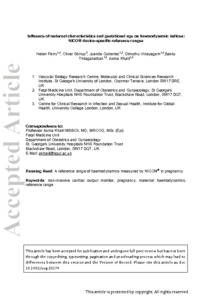Perry, H; Stirrup, O; Gutierrez, J; Vinayagam, D; Thilaganathan, B; Khalil, A
(2019)
Influence of maternal characteristics and gestational age on hemodynamic indices: NICOM device‐specific reference ranges.
Ultrasound Obstet Gynecol, 54 (5).
pp. 670-675.
ISSN 1469-0705
https://doi.org/10.1002/uog.20179
SGUL Authors: Khalil, Asma
![[img]](https://openaccess.sgul.ac.uk/110478/1.hassmallThumbnailVersion/Perry_et_al-2018-Ultrasound_in_Obstetrics_%2526_Gynecology%20Influence_of_maternal_characteristics.pdf)  Preview |
|
PDF
Accepted Version
Available under License ["licenses_description_publisher" not defined].
Download (775kB)
| Preview
|
Abstract
Objectives
To construct reference ranges for stroke volume, cardiac output and systemic vascular resistance (SVR) in normal pregnancy for the NICOM® device, and to explore associations between maternal characteristics and these hemodynamic variables.
Methods
This was a prospective cohort study of healthy singleton pregnancies between 10 and 40 weeks' gestation attending a tertiary referral hospital between September 2012 and May 2018. Measurements of stroke volume, cardiac output and SVR were obtained throughout pregnancy using NICOM, a non‐invasive device based on bioreactance technology. NICOM device‐specific reference ranges were created with respect to gestational age and maternal characteristics. Once the distribution of the data had been determined with respect to the gestational age, patient characteristics were added to the model to test whether they provided a significant improvement in prediction of the median value. The effect was assessed of maternal weight, height, smoking status, conception using assisted reproductive technology, nulliparity and ethnicity.
Results
We included 411 women in this study. The relationships between cardiac variables and gestational age observed in the NICOM‐specific reference ranges are consistent with previous findings, with increasing cardiac output values until around 35 weeks and a decrease thereafter until term, and decreasing SVR until around 36 weeks, followed by an increase towards 40 weeks. Stroke volume showed a small linear increase across gestation with lower variability in observations close to term. Maternal weight, height and age were associated with cardiac output (all P < 0.05) and SVR (all P < 0.01), whilst maternal weight and height were associated with stroke volume (both P < 0.001). Ethnicity was significantly associated with stroke volume (P = 0.001) but not with cardiac output or SVR.
Conclusions
This study presents device‐specific reference ranges for stroke volume, cardiac output and SVR for the NICOM device in healthy pregnancy and describes the maternal characteristics that are associated with the values of these hemodynamic measurements. Studies using NICOM in pregnancy can use these ranges in order to evaluate observations relative to those expected in uncomplicated pregnancy conditional on maternal characteristics.
| Item Type: |
Article
|
| Additional Information: |
This is the peer reviewed version of the following article: Perry, H. , Stirrup, O. , Gutierrez, J. , Vinayagam, D. , Thilaganathan, B. and Khalil, A. (2019), Influence of maternal characteristics and gestational age on hemodynamic indices: NICOM device‐specific reference ranges. Ultrasound Obstet Gynecol, 54: 670-675, which has been published in final form at https://doi.org/10.1002/uog.20179. This article may be used for non-commercial purposes in accordance with Wiley Terms and Conditions for Use of Self-Archived Versions. |
| Keywords: |
maternal haemodynamics, non-invasive cardiac output monitor, pregnancy, reference range, 1114 Paediatrics And Reproductive Medicine, Obstetrics & Reproductive Medicine |
| SGUL Research Institute / Research Centre: |
Academic Structure > Molecular and Clinical Sciences Research Institute (MCS) |
| Journal or Publication Title: |
Ultrasound Obstet Gynecol |
| ISSN: |
1469-0705 |
| Language: |
eng |
| Dates: |
| Date | Event |
|---|
| 5 November 2019 | Published | | 6 October 2019 | Published Online | | 9 November 2018 | Accepted |
|
| Publisher License: |
Publisher's own licence |
| PubMed ID: |
30548496 |
 |
Go to PubMed abstract |
| URI: |
https://openaccess.sgul.ac.uk/id/eprint/110478 |
| Publisher's version: |
https://doi.org/10.1002/uog.20179 |
Statistics
Item downloaded times since 19 Dec 2018.
Actions (login required)
 |
Edit Item |



